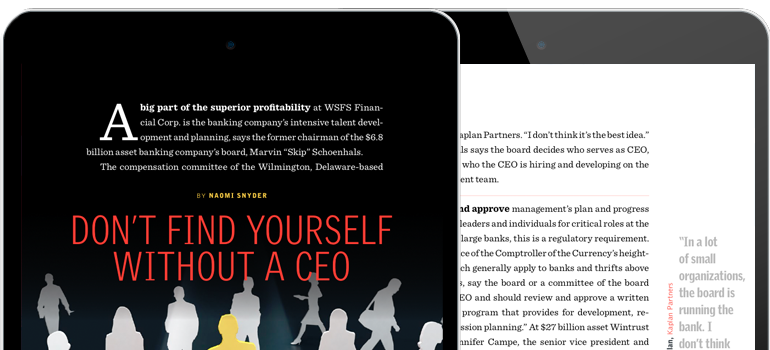
Don’t Find Yourself Without a CEO

A big part of the superior profitability at WSFS Financial Corp. is the banking company’s intensive talent development and planning, says the former chairman of the $6.8 billion asset banking company’s board, Marvin “Skip” Schoenhals.
The compensation committee of the Wilmington, Delaware-based bank reviews at least annually management’s plans to develop potential candidates not only for C-suite jobs, but also another level down, the bank’s executive vice presidents and senior vice presidents. The full board reviews an abbreviated version of the report. Plus, the bank often rotates executives into new positions so they can learn about other areas of the bank and develop new skills, as the bank recently did in creating a risk officer position for an executive.
It’s no accident, then, that the bank has achieved return on assets above 1 percent and double digit return on equity for each of the last four years, according to data from independent research firm Morningstar.
“While strategic planning is absolutely essential, we believe culture eats strategic planning for breakfast,” Schoenhals says. “Our culture is our strategic advantage and when we promote someone, we want someone to know our culture and eat, breathe and sleep it. That puts a premium on growing from within.”
Not every bank board focuses on development of management quite to that extent, and in fact, many boards don’t even focus on developing candidates for the CEO’s job. In Bank Director’s 2017 Compensation Survey, nearly half of all respondents said they didn’t have a successor to replace the CEO when that executive retires or leaves.
Laura Hay, managing director for compensation consultant Pearl Meyer & Partners, says she often encounters new clients who don’t have any succession planning in place for the CEO, which puts the organization in a vulnerable position when the CEO leaves, and the bank struggles to find a suitable replacement.
While it’s management’s job to develop talent throughout the organization, it doesn’t always get done, and that’s where the board comes in. “Everybody says, yeah, we do that,” Hay says. “The board has to set out a process in their agendas to make sure it’s happening and make sure everyone is accountable.” Many bank boards show a preference for remaining independent, but if they don’t have a CEO succession plan in place, that commitment seems questionable. “If you don’t have the talent inside the organization, things can turn on a dime pretty quickly,” Hay says.
That’s not to say holding management accountable for developing successors is easy. After all, how many people really want to train a replacement to take their job? The board’s role is to provide oversight without overstepping, that is, without doing the actual work of leadership development. From interviews with bank directors and compensation consultants, we compiled the following list of do’s and don’ts to help boards navigate these tricky issues of leadership development and succession planning.
1. Do stay actively engaged in assessing and picking candidates for the CEO position. It’s often said that picking the CEO is the most important job of the board, not without good reason. Many bank boards will take suggestions and input from the CEO, but control the reins in terms of assessing and selecting candidates as successors to the CEO. While there is not a specific regulatory rule that banks maintain a CEO-in-waiting, much of the guidance says the board is responsible for succession planning.
2. Don’t make other hiring decisions. Depending on the size of the organization, the board should defer to the CEO’s decision on most hiring. After all, management should be running the bank. “In a lot of small organizations, the board is running the bank,” says Alan Kaplan, founder and CEO of executive search and advisory firm, Kaplan Partners. “I don’t think it’s the best idea.” At WSFS, Schoenhals says the board decides who serves as CEO, but simply monitors who the CEO is hiring and developing on the rest of the management team.
3. Do review and approve management’s plan and progress in developing leaders and individuals for critical roles at the company. For large banks, this is a regulatory requirement. For example, the Office of the Comptroller of the Currency’s heightened standards, which generally apply to banks and thrifts above $50 billion in assets, say the board or a committee of the board should “appoint a CEO and should review and approve a written talent management program that provides for development, recruitment and succession planning.” At $27 billion asset Wintrust Financial Corp., Jennifer Campe, the senior vice president and chief human resources officer, makes presentations to the board annually where she distributes the equivalent of baseball cards detailing the photos and backgrounds of candidates for senior executive roles, including CEOs at the company’s 15 chartered bank subsidiaries. She lets the board know what the company’s plan is for development of the leaders and alerts them when one of them is scheduled to speak before the board, so the board will give that person special attention.
4. Don’t be afraid to ask questions about what’s being done to develop high performers within your organization. Managers may be too busy with day-to-day tasks to focus on this to the degree that they should. “The weakest link is often the manager of a high-potential, high-performing employee,” Kaplan says.
5. Don’t make decisions about each person’s individual development plan, for example, whether a certain school’s leadership training is better than another, says Hay.
6. Do hold management accountable. One bank that Hay worked with set up incentive pay to ensure the CEO trained a successor for his job, introduced him to clients and paved the way for his successor’s actual success. Keep in mind, there is often an inherent conflict of interest for a CEO asked to train a successor. A CEO may get a bonus of three times base pay if he sells the bank, but nothing if he trains a successor, says Hay.
7. Do ask questions about what your bank is doing to develop the next generation of employees to accommodate changes in the market and changing demographics. A lot of banks give lip service to the notion that they want to hire millennials, but then run job advertisements in the local newspapers instead of social media, Hay says. Also, the digital demands of customers are changing rapidly, and the board should be asking questions about how the bank is approaching talent development to address these needs. “How will the bank be different in a few years, and how is the bank addressing that?” Hay asks.
Leadership development is important to any bank’s strategy if the bank’s board is planning a future as an independent entity. Some compensation consultants think the increase in consolidation in recent years has been partly a result of lack of succession planning at many banks, because they can see what happens to their clients when succession planning fails. Among the 240 bank mergers and acquisitions announced last year, 209 of them were for banks below $1 billion in assets. “Part of the reason we see all this consolidation is because boards haven’t been very active in leadership development,” Hay says. Also, having a talent development plan that aligns with your company’s strategic and growth plans is a basic step to getting them accomplished. “How can you have a growth strategy if you don’t have alignment with people strategy and business strategy?” Kaplan asks.

Join OUr Community
Bank Director’s annual Bank Services Membership Program combines Bank Director’s extensive online library of director training materials, conferences, our quarterly publication, and access to FinXTech Connect.
Become a Member
Our commitment to those leaders who believe a strong board makes a strong bank never wavers.


